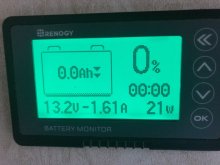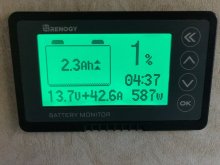padredw
New Member
Report on running Air Conditioner -- 15000 btu with ezy start
ran about 5 minutes before causing trip and shut down. (Phone/camera was plugged in at house so no photo. My best recording.)
while running - 1.3 Kw - 103 A 195 Ah remaining
--------
@ tripped 0% % shown, 0:00 Ahrs, 0:00 (time) 12.5 v-4.34 A display blinking.
-------
reset not long then still showing 0% capacity and 0.00 Ah remaining -- same as with microwave.
I'm sorry about lack of actual display. My recording is not so good.
I am now convinced about tripping.
ran about 5 minutes before causing trip and shut down. (Phone/camera was plugged in at house so no photo. My best recording.)
while running - 1.3 Kw - 103 A 195 Ah remaining
--------
@ tripped 0% % shown, 0:00 Ahrs, 0:00 (time) 12.5 v-4.34 A display blinking.
-------
reset not long then still showing 0% capacity and 0.00 Ah remaining -- same as with microwave.
I'm sorry about lack of actual display. My recording is not so good.
I am now convinced about tripping.





